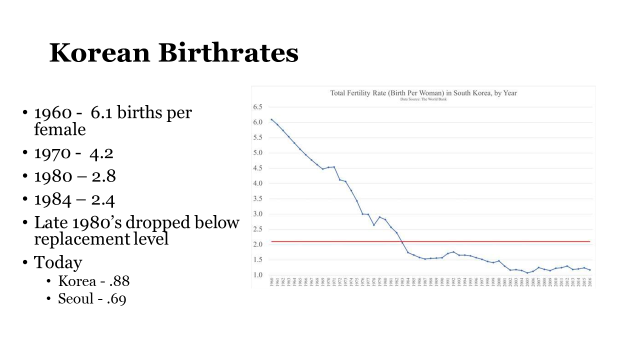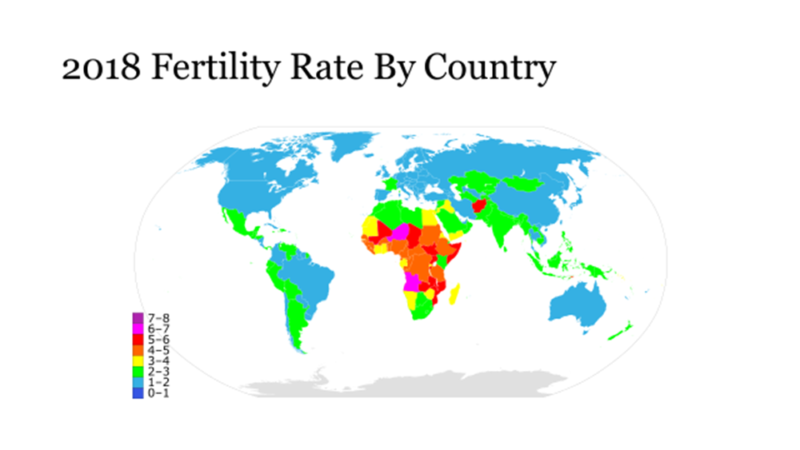South Korea has been the crown jewel of evangelical missionary service since World War 2 but it may soon be “extinct” because everyone was preaching the gospel of salvation and no one was teaching “be fruitful, multiply and fill the earth.”
Declining Korean Birthrates
This Bloomberg headline says it all: South Korea Set to Break Own Record on World’s Lowest Birth Rate. The Replacement Fertility Rate needed to maintain a society’s population is 2.13. No country below 1.3 has ever reversed that population decline.
 In 2019 South Korea dipped to 0.88, the lowest birthrate in the world. The rate in the capital city of Seoul is even lower at .69. This is a human and national disaster! Between the 1950s and the 2020s Korea abandoned their maternal instincts for a post-maternal culture. The decline of family formation followed, and the population has plunged.
In 2019 South Korea dipped to 0.88, the lowest birthrate in the world. The rate in the capital city of Seoul is even lower at .69. This is a human and national disaster! Between the 1950s and the 2020s Korea abandoned their maternal instincts for a post-maternal culture. The decline of family formation followed, and the population has plunged.
A headline in the National Interest screams, “Korea’s Future Is Dying (Thanks to Demographics).” Korea’s rapidly aging populace, her alarming suicide rate and paltry fertility rate will trigger a rapid population decline in 2020. South Korea is committing national suicide.
A global-level problem
South Korea is among the most endangered, but not alone among nations threatened by a population dearth. Post-family culture is growing globally, especially in industrialized, materialistic societies, where consumerism is attacking family formation. China, for example, has nearly 200 million unmarried adults.
Joel Kotkin, Presidential Fellow in Urban Futures at Chapman University, writes in Quillette, “Nearly 70 percent of China’s adults aged between 18 and 36 are on their own.” Kotkin’s article, “The Politics of Procreation,” uses striking language to sound a warning.
Throughout the world, the urban centers that dominate contemporary economy and culture—Beijing, Tokyo, New York, Los Angeles, Boston, Sydney, and San Francisco—are becoming “demographic graveyards.” In Beijing and Shanghai, the fertility rate is barely one-third of that needed to replace the current population. Inner London, notes the Office for National Statistics (ONS), has a fertility rate fully one-third lower than the surrounding suburbs. In severely overcrowded Hong Kong, according to one recent survey, two-thirds of women said they did not want an additional or even a first child. The fertility rate in the Chinese territory is now less than half that of 1980.
Today, a majority of people live in countries with fertility well below replacement rates. This number will grow to 75 percent by 2050, according to the UN; rapid aging, and a declining workforce, will become increasingly common around the world.
Fertility ratings
National fertility measures divide into three levels. A rate of 2.1 children per woman represents a stable or growing population. Approximately 100 countries are at or above this level.
this level.
About 50 nations have begun to fall in population and are between 2.1 and 1.8, slightly below the replacement level. These countries can reverse their decline with a concerted national effort.
A rate of 1.8 or below is “sub-replacement fertility.” Sixty-six countries are in this “death spiral,” a grave danger increasingly difficult to reverse. A nation in this range is in the process of national suicide. The tragic irony: many people believe the planet is overpopulated. Often, by the time a nation acknowledges the truth, it’s too late to change the anti-maternal culture.
No country has ever reversed a birthrate of 1.3 or below, known as the “lowest-low fertility.” Eleven countries—including Singapore, Taiwan, Hong Kong, Puerto Rico, and South Korea—have passed this point of no return. An average of one child per woman cuts a nation’s population in half in 30 years.
The graphic shows the global pattern of fertility in 2018. Growth has dropped in virtually every nation, including Sub-Saharan Africa, where the average rate in 2018 was 4.78.
US not excluded
In the US the same downward trends are at work. In January 2010 the Center for Disease Control published Expected Number of Births over a Woman’s Lifetime* — National Vital Statistics System, United States, 1940–2018.
During 1940–2018, the expected number of births a woman would have over her lifetime, the TFR, was highest for women during the post-World War II baby boom (births during 1946–1964). In 1957, the TFR reached a peak of 3.77 births per woman. The TFR generally declined for the birth cohort referred to as Generation X from 2.91 in 1965 to 1.84 in 1980. For the birth cohorts referred to as Millennials (Generation Y) and Generation Z, the TFR first increased to 2.08 in 1990 and then remained generally stable until it began to decline in 2007. By 2018, the expected number of births per women fell to 1.73, a record low for the nation. Except for 2006 and 2007, the TFR has been below the level needed for a generation to replace itself (2.10 births per woman) since 1971.
 Small cities, towns and suburbs generally support family formation and children. Larger cities have smaller families. In 2015, 25 percent of US households were single-person. These realities develop political implications. Two-thirds of single women support the Democratic Party, at least in part because their platform supports abortion. A “simple” procedure allows women to be like men: to have sex and not be pregnant. On the other hand, married women with children tend to be Republicans.
Small cities, towns and suburbs generally support family formation and children. Larger cities have smaller families. In 2015, 25 percent of US households were single-person. These realities develop political implications. Two-thirds of single women support the Democratic Party, at least in part because their platform supports abortion. A “simple” procedure allows women to be like men: to have sex and not be pregnant. On the other hand, married women with children tend to be Republicans.
One nation, two mindsets
Two cultural mindsets divide the US. One side values singleness, minimal responsibilities, freedom to consume. The other treasures community, families, “being” more than “having.”
In his article, Joel Kotkin engages the deeper philosophical, theological questions as well. What does it mean to be human? Do we have no more value than a cockroach? Are we the cancers of the earth, or the stewards of creation? Consumers or creators? Can we have a hopeful future based on the existence of a beneficent Creator, or do we live in a silent universe without purpose? The answers will shape our future.
- Darrow Miller
… to be continued






